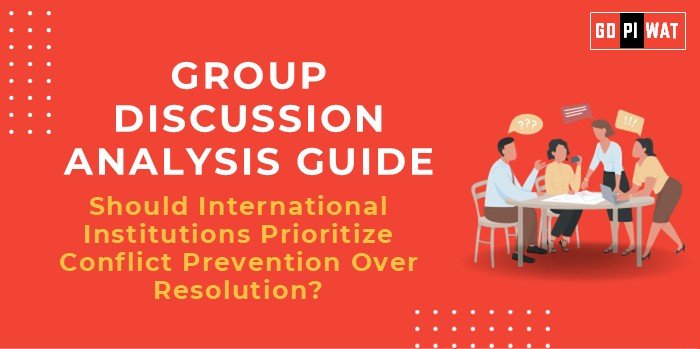📋 Group Discussion (GD) Analysis Guide
🌐 Should International Institutions Prioritize Conflict Prevention Over Resolution?
📖 Introduction to the Topic
Opening Context: International institutions like the United Nations (UN), the European Union (EU), and the African Union (AU) play pivotal roles in global peace and stability. The debate over whether their efforts should prioritize preventing conflicts rather than resolving them is vital for future global governance.
Topic Background: Post-World War II, international organizations were established to resolve conflicts and prevent future wars. However, their effectiveness in conflict prevention has been questioned amidst rising global tensions and limited resources.
📊 Quick Facts and Key Statistics
- 🌍 Global Conflict Cost: $14.76 trillion annually, equating to 10.5% of global GDP (Institute for Economics and Peace, 2023).
- 💼 Conflict Prevention Funding: Only 10-15% of peacekeeping budgets are allocated to preventive measures (UNDP Report, 2023).
- 🌐 UN Peacekeeping Missions: 87 since 1948, with varying success rates.
- 📉 Civil War Risk Reduction: Prevention reduces chances by 30% (World Bank, 2022).
🌟 Stakeholders and Their Roles
- 🏛️ United Nations (UN): Coordinating preventive diplomacy and peacekeeping missions.
- 🌍 Regional Organizations: AU and EU mediate local disputes and support development to address root causes.
- 🌐 National Governments: Implement policies ensuring stability.
- 🤝 Non-Governmental Organizations (NGOs): Focus on mediation and conflict prevention on the ground.
- 🏢 Private Sector: Invest in conflict-prone regions to promote stability.
🏆 Achievements and Challenges
✨ Achievements
- ✅ EU’s Preventive Diplomacy: Stabilized the Balkans in the 1990s.
- 🌱 UN Development Programs: Address root causes of conflict in Africa and Asia.
- 📘 Case Study: Rwanda’s recovery post-genocide through multi-stakeholder cooperation.
⚠️ Challenges
- 💵 Limited Funding: Prevention receives a fraction of peacekeeping budgets.
- ⚔️ Political Will: Discrepancies among nations hinder coordinated action.
- 📉 Case Study: Failure to prevent the Syrian Civil War despite early warnings.
📘 Global Comparisons:
– Success: Scandinavian nations have invested in conflict prevention globally, reducing war risks.
– Failure: The international response to Yemen’s humanitarian crisis.
💬 Structured Arguments for Discussion
- ✅ Supporting Stance: “Preventive action is cost-effective and saves lives. Investing in early warning systems and mediation saves trillions and countless lives.”
- ❌ Opposing Stance: “Conflict resolution is more tangible and measurable. Immediate action on conflicts creates direct stability and public confidence.”
- ⚖️ Balanced Perspective: “Both are essential but prevention offers long-term benefits. A balanced focus is ideal; prevention reduces conflicts, while resolution builds trust in institutions.”
💡 Effective Discussion Approaches
- 🌏 Opening Approaches:
- Start with data: “With global conflict costs at $14.76 trillion, prevention seems a pragmatic approach.”
- Highlight historical failures: “The Syrian Civil War highlights the need for early intervention.”
- 🤔 Counter-Argument Handling:
- Example-based rebuttal: “While resolving conflicts shows immediate results, Finland’s investment in education reduced conflict risks long-term.”
- Data emphasis: “UN studies show prevention cuts post-conflict costs by 50%.”
🔍 Strategic Analysis of Strengths and Weaknesses
- 💪 Strengths: Proactive, cost-effective, life-saving.
- ⚖️ Weaknesses: Intangible metrics, requires foresight.
- 📈 Opportunities: Leverage technology for early warning.
- ⚠️ Threats: Lack of global cooperation, political interests.
🎓 Connecting with B-School Applications
- 🌍 Real-World Applications: Policies on corporate social responsibility in conflict zones.
- 💬 Sample Interview Questions:
- “How can businesses contribute to conflict prevention?”
- “Should financial institutions support post-conflict rebuilding over prevention?”
- 💡 Insights for B-School Students:
- Integrate conflict prevention themes in international business strategies.
- Emphasize sustainable development goals during internships.


